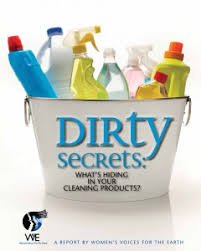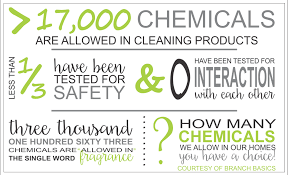5 Worst Chemicals in Your Cleaning Products (and the Safe Alternatives to Use Instead)

Did you know that many of the products we use to clean our homes and businesses are full of toxins? But fortunately, we don’t need to sacrifice cleanliness for safety. Here are some common household chemicals that pose health dangers, as well as safe, natural alternatives for them.
Lye, ethanol, ammonia, triclosan, hydrochloric acid, formaldehyde and other harmful ingredients are contained within a plethora of products such as cleaning agents, antibacterial soaps, bleach and disinfectants. Such chemicals are linked to asthma, cancer, skin disorders and reproductive problems.
Moreover, a study at the University of Bergen in Norway found people who clean their homes regularly have a 14-percent higher risk of suffering from a reduction in lung function over the next 20 years. While lung function declines with age, the inhalation of toxic fumes from cleaning agents accelerates the deterioration.Although the list of harmful chemicals in cleaning products is extensive, the following ones are among the worst:
- Chlorine-based compounds like sodium hypochlorite, the active ingredient in bleach, can irritate the airways, skin and eyes even at low doses. Mixing bleach with other cleaning products can produce a deadly gas.
- 1,4-Dioxane is a carcinogen that laces numerous products. The kidneys and liver are target organs for its toxicity.
- Benzalkonium chloride, a disinfectant, is associated with serious respiratory, skin and eye irritations.
- Terpenes, found in lemon- and pine-scented cleaning products, increase the risk of asthma. Even more alarming, when they come in contact with ozone in the home, they transform into formaldehyde, a chemical linked to cancer.
- Isothiazolinones is responsible for an increase in contact dermatitis, a skin condition involving redness, itchiness and blisters.
It’s good to be familiar with common toxins, but the absence of these chemicals on a cleaning product label doesn’t ensure safety. According to the Environmental Working Group, only 7 percent of such products on the market fully disclose their contents.

Some “Green” Cleaners Are Toxic
Noted natural health practitioner Dr. Joseph Mercola warns that some cleaning products labeled “green” or “natural” are also full of harmful ingredients. These claims are merely marketing terms, and because the industry is only minimally regulated, they aren’t dependable indicators that a product is safe. For instance, a popular cleaning agent called Simple Green claims to be nontoxic, yet it contains 2-Butoxyethanol, a chemical classified as dangerous by the European Union.
A 2010 study tested 25 household scented products that included cleaning agents, half of which claimed to be organic, natural or green. The researchers found each product contained 17 chemicals. However, only one chemical was listed on the labels. Of the 133 chemicals detected, approximately 25 percent were categorized as hazardous or toxic substances under federal law.

Homemade Natural Alternatives Are Your Safest Bet
For housecleaning, you can use natural agents, many of which are typically found in the pantry. It’s surprising how well they work. Consider tossing out all the toxin-laden products in your home and replacing them with the items below:
- Baking soda has virus-killing properties and a granular texture, which makes it useful for scrubbing the bathroom and kitchen. It’s also a substitute for silver polish. In addition, when mixed with apple cider vinegar, baking soda is an alternative to drain cleaners.
- White vinegar can effectively clean soap scum, grim and grease. It can also be used in place of toxic dryer fabric softener sheets. A solution of 50 percent vinegar and 50 percent water will clean glass and windows. Vinegar sprayed over baking powder makes a good all-purpose cleanser.
- Lemon juice has antibacterial properties that eliminate mold and mildew. It also removes stains, shines hard surfaces and imparts a wonderful scent. Recipes can be found online for making an all-purpose cleaner using lemons, vinegar and water.
- Castile soap is made with olive oil or other vegetable oils, and it contains no chemical detergents. It can be purchased in health food stores. The liquid form makes a good dishwashing or laundry detergent. A solution of the liquid with other ingredients can clean almost anything. For example, a combination of castile soap, water and essential pine oil can replace a pine cleaner, and a mixture of the soap, water and vodka makes a counter disinfectant.
- Organic essential oils, such as the pine oil mentioned above, can be used in homemade cleaning products in place of synthetic fragrances. Some oils like lavender and rosemary have antibacterial properties, a benefit that gives them a dual purpose.
By Mary West
http://www.liveinthenow.com/article/toxic-chemicals-cleaning-products-safest-natural-alternatives